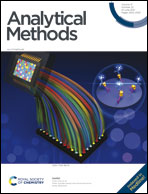Reasonable design of an MXene-based enzyme-free amperometric sensing interface for highly sensitive hydrogen peroxide detection†
Abstract
Sensitive detection of H2O2 in the nano- to micromolar range is critical for health monitoring and disease diagnosis. Two-dimensional transition metal carbides or/and nitrides (called MXenes, MXs) have excellent potential applications in the electrochemical field due to their outstanding electrical conductivity and catalytic properties. In this work, Ti3C2Tx (MX) was employed for the construction of a sensitive and enzyme-free electrochemical sensing interface for the detection of hydrogen peroxide (H2O2) through a simple and effective method. Prussian blue (PB) was electrochemically deposited on the surface of a glassy carbon electrode (GCE). Chitosan (CS) and MX were sequentially dripped onto the PB modified GCE surface. The reasonable fabrication of the MX/CS/PB/GCE sensing interface presented good electrochemical sensing performance towards H2O2 with a low limit of detection (4 nM), a wide linear range from 50 nM to 667 μM and good selectivity. The proposed MX/CS/PB/GCE has been proven to monitor H2O2 in food samples and biological samples with recoveries between 94.7% and 100.3%. This work has made a beneficial attempt and research for exploring and expanding the application of MXs in the field of electrochemical sensing.



 Please wait while we load your content...
Please wait while we load your content...